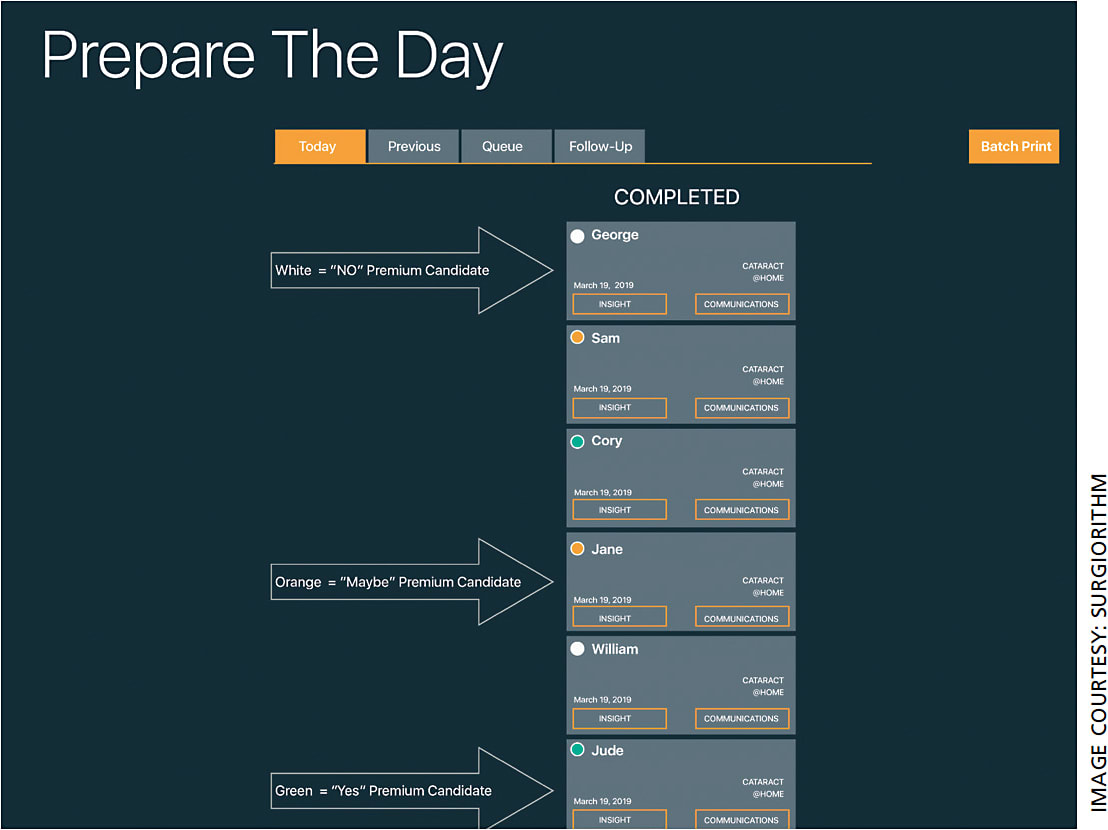Surgiorithm software helps optimize your cataract patient’s office visit.
As a cataract surgeon, you strive to provide each patient with a personalized experience, understanding the patient’s lifestyle and visual goals so you can provide an optimal outcome. Unfortunately, your packed schedule may not allow you to understand each patient as well as you’d like when he or she visits your office to discuss cataract surgery options.
Surgiorithm can help you understand your patients’ needs before they arrive at your office, streamlining your chair time, increasing education and potentially increasing premium surgery rates, patient volume and revenue — all crucial in an era of declining reimbursement. Founded in 2016, Surgiorithm is based in Nashville, Tenn.


PERSONAL CONNECTION
Once patients are registered to the Surgiorithm system by the practice, the program starts with a live phone call or text from Surgiorithm to patients scheduled for cataract evaluation (this outreach is branded for your practice). Patients then receive an e-mail with a secure link to an online education program to complete at home, made of three parts: a questionnaire, a package comparison chart and videos.
The questionnaire is personalized, interactive and responsive to patients’ answers. It focuses on visual, lifestyle, personality and financial factors. The result: a patient insight report. (For patients who don’t use e-mail or speak only Spanish, Surgiorithm conducts the preparation by phone.)
Each patient is then introduced to a customized, practice-branded IOL package comparison followed by video education.
On the practice side, the Surgiorithm patient journey dashboard is used to access the patient insight report, per unique patient. This report includes a proprietary “predictor” — a color-coded number that represents the likelihood of premium procedure adoption. The report also includes lifestyle and financial preferences, as well as vision goals. Armed with this information, the surgeon can have a focused, productive conversation with the patient, understanding whether the patients are candidates for a premium service.
Surgiorithm also provides a key performance indicator report that allows a practice to track trends. It includes information about such items as referral sources and premium acceptance. The program is cloud-based and HIPAA secure. Each doctor pays a monthly licensing fee plus a per-patient fee for the contact center outreach.
GUIDING THE CONVERSATION
Surgiorithm “has the kind of conversation with the patient ahead of time that you can glance at and learn what’s important to the patient before they even come in,” says Amy Zimmerman, MD, Katzen Eye Group, Baltimore, Md. “It guides you as to what their interests are, what their activity level is, what their expectations are postop.”
“We walk in the room knowing what kind of conversation to have with the patient,” adds Dr. Zimmerman. “The patient’s already been primed with enough information that he or she is making an educated decision.”
The patient insight report that the practice receives is “quite accurate,” according to William Wiley, MD, medical director, Cleveland Eye Clinic. “It does a good job of putting the patients in the proper buckets” of definitely interested, definitely not interested and potentially interested in an upgrade or premium cataract service.
The patient insight report helps to narrow down information such as the patient’s visual goals and personality, notes Krystle Momosor, clinical operations manager, Cleveland Eye Clinic. This, Ms. Momosor says, helps the Cleveland Eye Clinic patient educator conduct a targeted conversation about the patient’s preferred options for cataract surgery, so the patient can make an informed decision.
INCREASED CONVERSIONS AND VOLUME
The Surgiorithm program has led to increased premium conversion rates for both Dr. Zimmerman and Dr. Wiley. Prior to Surgiorithm, Dr. Zimmerman’s premium conversion rate was 8% to 10%; since the program, it’s increased to about 35% to 40%.
Dr. Wiley says that his practice, which has used Surgiorithm for roughly a year and a half, has had a “modest increase” in conversion rates. In addition to these conversions, “what we saw was increased cataract surgery volume, because we were more efficient in the process of being able to work through patients,” he explains.
HIGH-QUALITY EDUCATION
While noting this increase in conversion rates and patient volume, Dr. Wiley stresses that patient education is one of the major benefits of the Surgiorithm program. He wants to ensure that patients understand their surgery options.
“That every patient going through our process is educated in a high-quality manner to me is a huge success,” Dr. Wiley says.
“Our goal is never to push an upgrade on patients,” says Ms. Momosor. “Our goal is to educate patients and let them make the decision as to what’s going to benefit them, what’s going to give them the visual outcome that they’re looking for to suit their particular lifestyle. Surgiorithm has really helped us accomplish that goal.” OM








